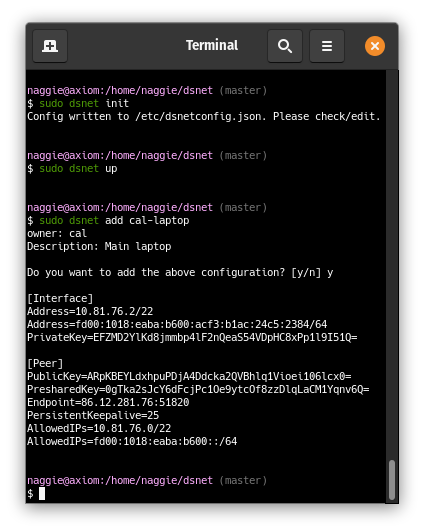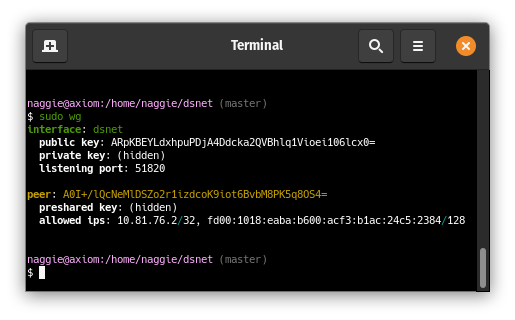dsnet is a simple configuration tool to manage a centralised wireguard VPN. Think wg-quick but quicker. From scratch:
The server peer is listening, and a client peer config has been generated and added to the server peer:
More client peers can be added with dsnet add. They can connect immediately after!
It works on AMD64 based linux and also ARMv5.
Usage: dsnet <cmd> Available commands: init : Create /etc/dsnetconfig.json containing default configuration + new keys without loading. Edit to taste. add : Add a new peer + sync up : Create the interface, run pre/post up, sync report : Generate a JSON status report to the location configured in /etc/dsnetconfig.json. remove : Remove a peer by hostname provided as argument + sync down : Destroy the interface, run pre/post down sync : Update wireguard configuration from /etc/dsnetconfig.json after validating Quick start (AMD64 linux) -- install wireguard, then, after making sure /usr/local/bin is in your path:
sudo wget https://github.com/naggie/dsnet/releases/download/v0.1/dsnet-linux-amd64 -O /usr/local/bin/dsnet sudo chmod +x /usr/local/bin/dsnet sudo dsnet init # edit /etc/dsnetconfig.json to taste sudo dsnet up sudo dsnet add banana > dsnet-banana.conf sudo dsnet add apple > dsnet-apple.conf Copy the generated configuration file to your device and connect!
To send configurations, ffsend (with separately transferred password) or a local QR code generator may be used.
The peer private key is generated on the server, which is technically not as secure as generating it on the client peer and then providing the server the public key; there is provision to specify a public key in the code when adding a peer to avoid the server generating the private key. The feature will be added when requested.
Configuration overview
dsnetconfig.json is the only file the server needs to run the VPN. It contains the server keys, peer public/shared keys and IP settings. A working version is automatically generated by dsnet init which can be modified as required.
Currently its location is fixed as all my deployments are for a single network. I may add a feature to allow setting of the location via environment variable in the future to support multiple networks on a single host.
Main configuration example:
{ "ExternalIP": "198.51.100.2", "ListenPort": 51820, "Domain": "dsnet", "InterfaceName": "dsnet", "Network": "10.164.236.0/22", "IP": "10.164.236.1", "DNS": "", "Networks": [], "ReportFile": "/var/lib/dsnetreport.json", "PrivateKey": "uC+xz3v1mfjWBHepwiCgAmPebZcY+EdhaHAvqX2r7U8=", "Peers": [ { "Hostname": "test", "Owner": "naggie", "Description": "Home server", "IP": "10.164.236.2", "Added": "2020-05-07T10:04:46.336286992+01:00", "Networks": [], "PublicKey": "altJeQ/V52JZQrGcA9RiKcpZusYU6zMUJhl7Wbd9rX0=", "PresharedKey": "GcUtlze0BMuxo3iVEjpOahKdTf8xVfF8hDW3Ylw5az0=" } ] } Explanation of each field:
{ "ExternalIP": "198.51.100.2", This is the external IP that will be the value of Endpoint for the server peer in client configs. It is automatically detected by opening a socket or using an external IP discovery service -- the first to give a valid public IPv4 will win.
"ListenPort": 51820, The port wiregard should listen on.
"Domain": "dsnet", The domain to copy to the report file. Not used for anything else; it's useful for DNS integration. At one site I have a script to add hosts to a zone upon connection by polling the report file.
"InterfaceName": "dsnet", The wireguard interface name.
"Network": "10.164.236.0/22", The CIDR network to use when allocating IPs to peers. This subnet, a /22 in the 10.0.0.0/16 block is generated randomly to (probably) avoid collisions with other networks. There are 1022 addresses available. Addresses are allocated to peers when peers are added with dsnet add using the lowest available address.
"IP": "10.164.236.1", This is the private VPN IP of the server peer. It is the first address in the above pool.
"DNS": "", If defined, this IP address will be set in the generated peer wg-quick config files.
"Networks": [], This is a list of additional CIDR-notated networks that can be routed through the server peer. They will be added under the server peer under AllowedIPs in addition to the private network defined in Network above. If you want to route the whole internet through the server peer, add 0.0.0.0/0 to the list before adding peers. For more advanced options and theory, see https://www.wireguard.com/netns/.
"ReportFile": "/var/lib/dsnetreport.json", This is the location of the report file generated with dsnet report. It is suggested that this command is run via a cron job; the report can be safely consumed by a web service or DNS integration script, for instance.
The report contains no sensitive information. At one site I use it together with hugo shortcodes to generate a network overview page. The shortcode file is included in this repository under etc/.
"PrivateKey": "uC+xz3v1mfjWBHepwiCgAmPebZcY+EdhaHAvqX2r7U8=", The server private key, automatically generated and very sensitive!
"Peers": [] The list of peers managed by dsnet add and dsnet remove. See below for format.
} The configuration file can be manually/programatically managed outside of dsnet if desired; dsnet sync will update wireguard.
Peer configuration, Peers: [] in dsnetconfig.json:
{ "Hostname": "test", The hostname given via dsnet add <hostname>. It is used to identify the peer in the report and for peer removal via dsnet remove <hostname>. It can also be used to update a DNS zone via a custom script that operates on the report file as mentioned above.
"Owner": "naggie", The owner of the peer, copied to the report file.
"Description": "Home server", A description of the peer, copied to the report file; the lack of which in wq-quick is what inspired me to write dsnet in the first place.
"IP": "10.164.236.2", The private VPN IP allocated by dsnet for this peer. It is the lowest available IP in the pool from Network, above.
"Added": "2020-05-07T10:04:46.336286992+01:00", The timestamp of when the peer was added by dsnet.
"Networks": [], Any other CIDR networks that can be routed through this peer.
"PublicKey": "altJeQ/V52JZQrGcA9RiKcpZusYU6zMUJhl7Wbd9rX0=", The public key derived from the private key generated by dsnet when the peer was added.
"PresharedKey": "GcUtlze0BMuxo3iVEjpOahKdTf8xVfF8hDW3Ylw5az0=" The pre-shared key for this peer. The peer has the same key defined as the pre-shared key for the server peer. This is optional in wireguard but not for dsnet due to the extra (post quantum!) security it provides.
} Report file overview
An example report file, generated by dsnet report to /var/lib/dsnetreport.json by default:
{ "ExternalIP": "198.51.100.2", "InterfaceName": "dsnet", "ListenPort": 51820, "Domain": "dsnet", "IP": "10.164.236.1", "Network": "10.164.236.0/22", "DNS": "", "PeersOnline": 4, "PeersTotal": 13, "Peers": [ { "Hostname": "test", "Owner": "naggie", "Description": "Home server", "Online": false, "Dormant": true, "Added": "2020-03-12T20:15:42.798800741Z", "IP": "10.164.236.2", "ExternalIP": "198.51.100.223", "Networks": [], "Added": "2020-05-07T10:04:46.336286992+01:00", "ReceiveBytes": 32517164, "TransmitBytes": 85384984, "ReceiveBytesSI": "32.5 MB", "TransmitBytesSI": "85.4 MB" } <...> ] } Fields mean the same as they do above, or are self explanatory. Note that some data is converted into human readable formats in addition to machine formats -- this is technically redundant but useful with Hugo shortcodes and other site generators.
The report can be converted, for instance, into a HTML table as below:
See etc/README.md for hugo and PHP code for rendering a similar table.
FAQ
Does dsnet support IPv6?
Not currently but this is a planned feature.
Is dsnet production ready?
Absolutely, it's just a configuration generator so your VPN does not depend on dsnet after adding peers. I use it in production at 2 companies so far.
Note that before version 1.0, the config file schema may change. Changes will be made clear in release notes.
Why are there very few issues?
I'm tracking development elsewhere using dstask. I keep public initiated issues on github though, and will probably migrate issues over if this gains use outside of what I'm doing.
Client private keys are generated on the server. Can I avoid this?
Allowing generation of the pub/priv keypair on the client is not yet supported, but will be soon as provision exists within the code base. Note that whilst client peer private keys are generated on the server, they are never stored.
How do I get dsnet to bring the (server) interface up on startup?
Assuming you're running a systemd powered linux distribution (most of them are):
- Copy etc/dsnet.service to
/etc/systemd/system/ - Run
sudo systemctl daemon-reloadto get systemd to see it - Then run
sudo systemctl enable dsnetto enable it at boot
How can I generate the report periodically?
Either with cron or a systemd timer. Cron is easiest:
echo '* * * * * root /usr/local/bin/dsnet report | sudo tee /etc/cron.d/dsnetreport' Note that whilst report generation requires root, consuming the report does not as it's just a world-readable file. This is important for web interfaces that need to be secure.
This is also why dsnet loads its configuration from a file -- it's possible to set permissions such that dsnet synchronises the config generated by a non-root user. Combined with a periodic dsnet sync like above, it's possible to build a secure web interface that does not require root. A web interface is currently being created by a friend; it will not be part of dstask, rather a separate project.
from Hacker News https://ift.tt/3gjGFGi



No comments:
Post a Comment
Note: Only a member of this blog may post a comment.